From choosing which social media sites to focus on, to developing a rhythm of content that resonates with each platform’s audience, it’s no surprise that social media marketing can get overwhelming.
Nevertheless, social media is a huge component of personal and professional growth online. So, where do you start?
In this post, we’ll walk you through building an audience and monetizing your presence on popular social media platforms like Twitter (“X”), Facebook, LinkedIn, Instagram, YouTube and TikTok, plus we’ll point out each platform’s unique offerings and audience demographics.
By the end, you should be able to apply this way of thinking to your own brand to isolate which platforms might perform best for you.
Choosing the Right Platform
There’s a big misconception that every brand needs to be on every social platform. After all, if they aren’t, then they’re passing up potential audience exposure, right? Well, yes, to an extent. But exposure for the sake of exposure isn’t always productive in the way you need it to be.
Part of social media marketing is to build a rapport and relationship with your audience. If you can, you also want to drive revenue from those channels as well.
Every platform has its unique characteristics and caters to specific audiences, so the platforms you use will largely depend on what you want to accomplish. Let’s look at some considerations for choosing the right platform.
Consider Your Audience
The social media platforms you prioritize should align with your target audience:
- Twitter (“X”) may be perfect for a general audience
- Whereas LinkedIn is much better suited for business professionals
- And if your audience spends most of their time on TikTok, that’ll be one of the first places to build a presence
But what if you don’t know where your audience spends their time? That’s when you need to buckle down and browse those platforms for yourself.
The biggest indicator we look for is how active your competitors are on a given platform.
If content surrounding your industry feels desolate, odds are that your ideal audience isn’t on that specific social media platform.
Visibility
You can build an audience and increase visibility on any social media platform. The key is to create compelling content and use various post types.
Since short-form video generates the highest ROI of any social media marketing strategy, you should explore your options for producing videos that highlight what your brand does best.
Look at your offer and ask yourself how much of it you can give away for free in the form of a video:
- If you’re selling a product, this might be a series of product demonstrations or tutorial videos.
- If you’re selling a service, this might be a series of how-to videos on a complex subject (on which you are an expert), with a CTA encouraging your viewers to connect with you for more help.
It’s these short, digestible snippets of content that wet people’s appetites for your offer, making it easier for them to engage with your brand. Remember to make the video content you develop centered around helping the viewer who is seeking information.
Driving Website Traffic
75% of marketers say social media marketing increases website traffic. But how you use this tactic depends on your business, niche and audience.
Twitter (“X”) remains a powerful tool for driving website traffic. One of its unique advantages is its ability to attract new leads, increase your reach and enhance email list building. X is best for B2C brands in various industries, such as entertainment, health/fitness, travel, food/beverage and home. If you need help with managing Twitter accounts, consider professional services.
While some local service-based businesses may find success on X, Facebook offers more solutions for SMBs. Facebook is also better at increasing web traffic for fashion brands, especially ones that use Meta Ads in their strategy:
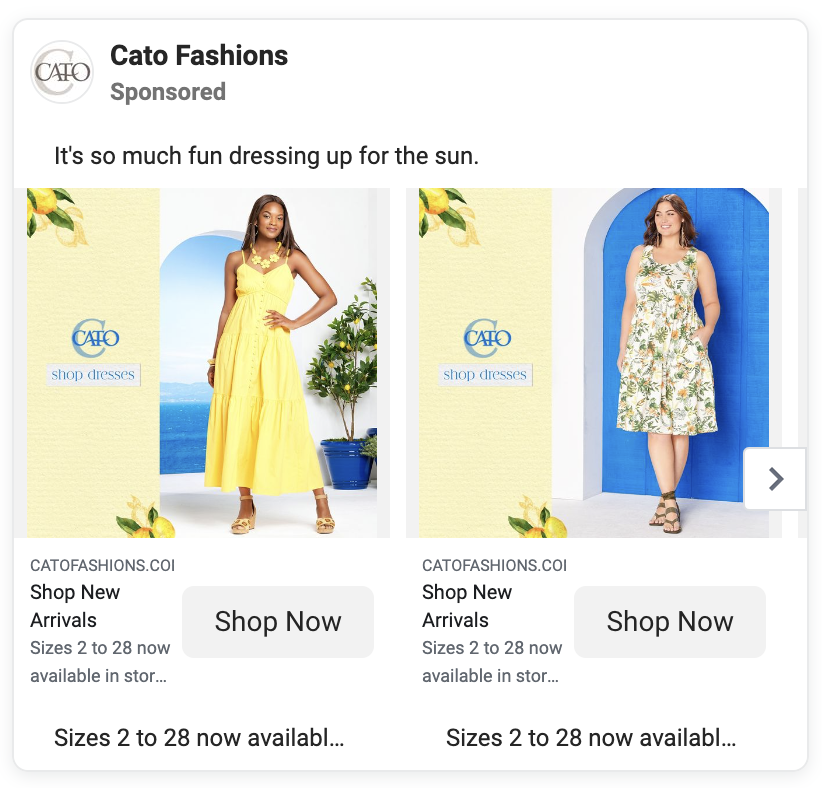
B2B and Professional Networking
75% of B2B buyers use social media to make purchasing decisions, but there are specific platforms that businesses in this space should use.
If you need a recommendation, LinkedIn is an ideal platform for those targeting a professional audience:
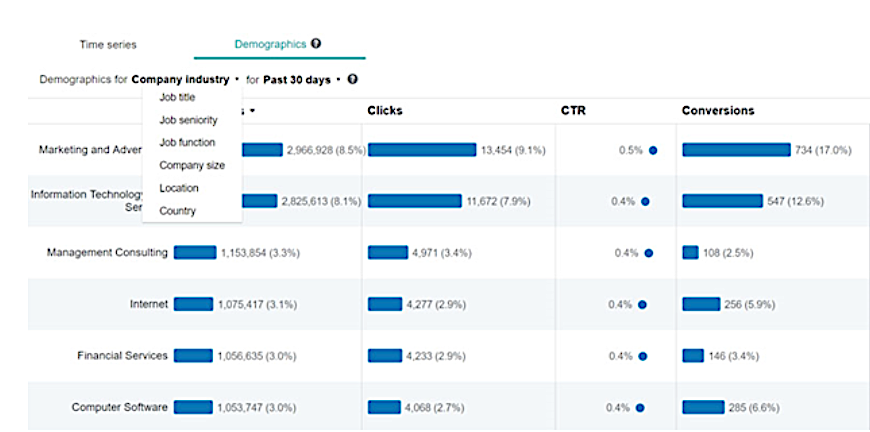
It often outperforms other sites such as X in terms of driving email subscriptions, recruiting employees, and networking with other professionals.
Since LinkedIn is known as a professional social platform, use this space to post content related to your business.
Using Each Social Media Platform
69% of marketers use social media to build brand awareness, but every network has its own features that you can use to enhance your visibility.
Here’s a brief walkthrough on how to leverage social media marketing on the most popular platforms.

Facebook has practically everything. It’s a great placement for written posts, both long-form and short-form. Videos perform well on it. Images perform well on it. You really can’t go wrong by featuring content on this channel.
Audience
Facebook has a diverse user base spanning different age groups and demographics, with the majority in the 18-34 age group:
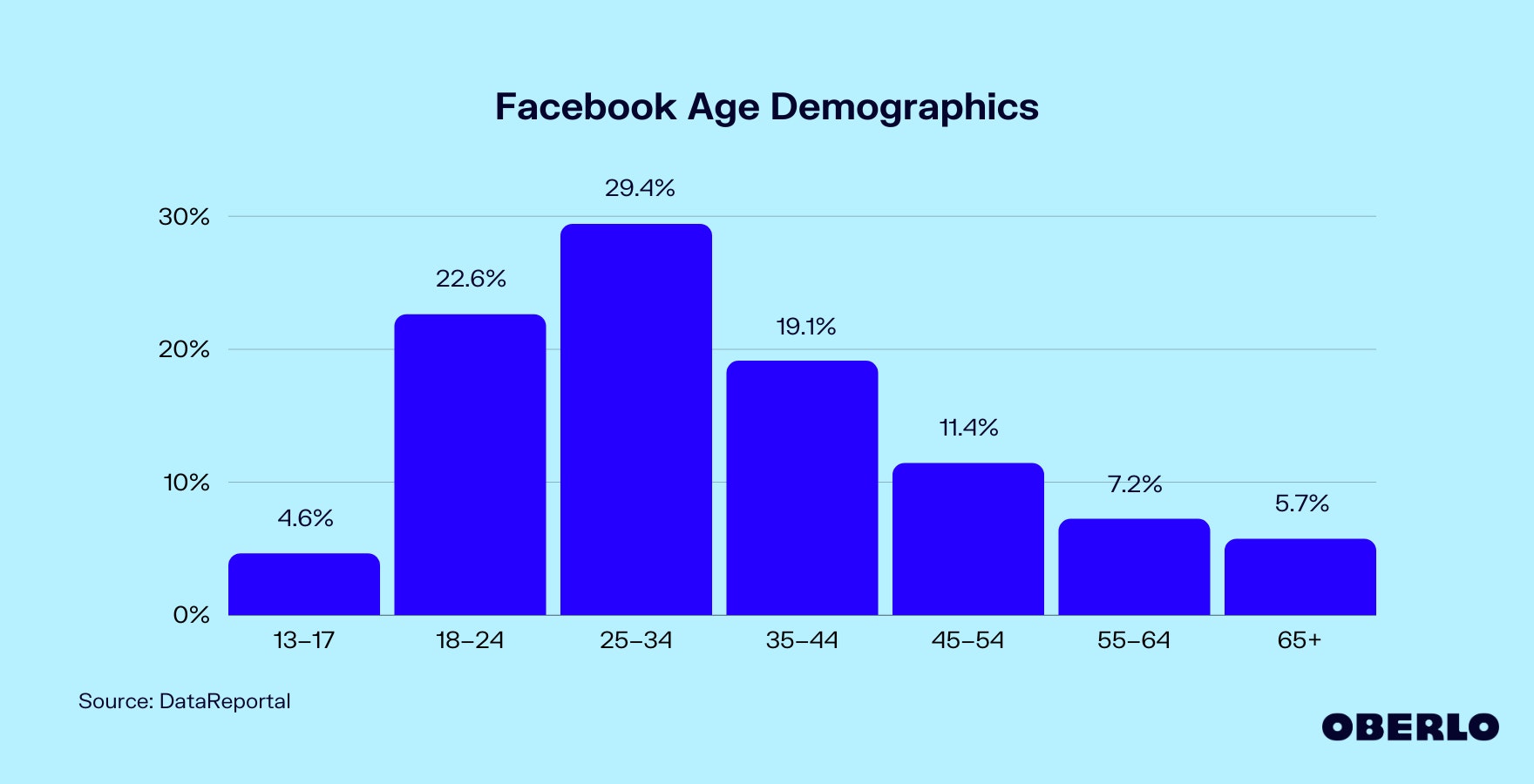
Strategies:
- Create a business page: Make a Meta business account with your brand’s logo, cover photo and detailed information.
- Content variety: Share a mix of content, including text, images and videos. If you want to include links to your website or blog, add them in the comments. But if you’re including a link on an ad, paste the link directly on the advertisement.
- Engagement: Encourage audience feedback by asking questions, conducting polls and responding to comments.
- Paid advertising: Use Facebook Ads to target specific demographics, interests and behaviors. Experiment with different ad formats like image ads, video ads and carousel ads.
- Facebook Groups: Create a branded Facebook Group to engage with a community interested in your company or niche.

Instagram is the cleaner, simpler alternative to Facebook. It mainly features images and videos, allowing those two formats to pop out more than on Facebook or X.
Audience
Younger users are Instagram’s main audience members, particularly Millennials and Gen Z.
Characteristics & Strategies:
- Visual storytelling: Focus on visual content, such as high-quality images and videos. Instagram Stories and Reels are best for short and engaging content.
- Hashtags: Use relevant hashtags to increase the discoverability of your content.
- Influencer partnerships: Collaborate with influencers in your niche to boost your visibility.
- Shopping features: If you own an e-commerce company, set up Instagram Shopping so users can purchase products directly through your posts.
- Consistent posting: Post regularly to grow your brand and engage your audience.
Twitter (“X”)

X is fast-paced. The content you post there has to be short and witty. You can also get away with posting a lot more frequently on this platform (as in multiple times per day, easily). X users practically expect new, fresh content from the same source within the same day.
It’s a great place to repurpose longer-form content from your other placements and parcel it out into smaller, digestible pieces that you can post periodically each day.
Audience
X is popular among professionals, journalists and those seeking breaking news. You’ll specifically want to target men in the 25-34 age group:
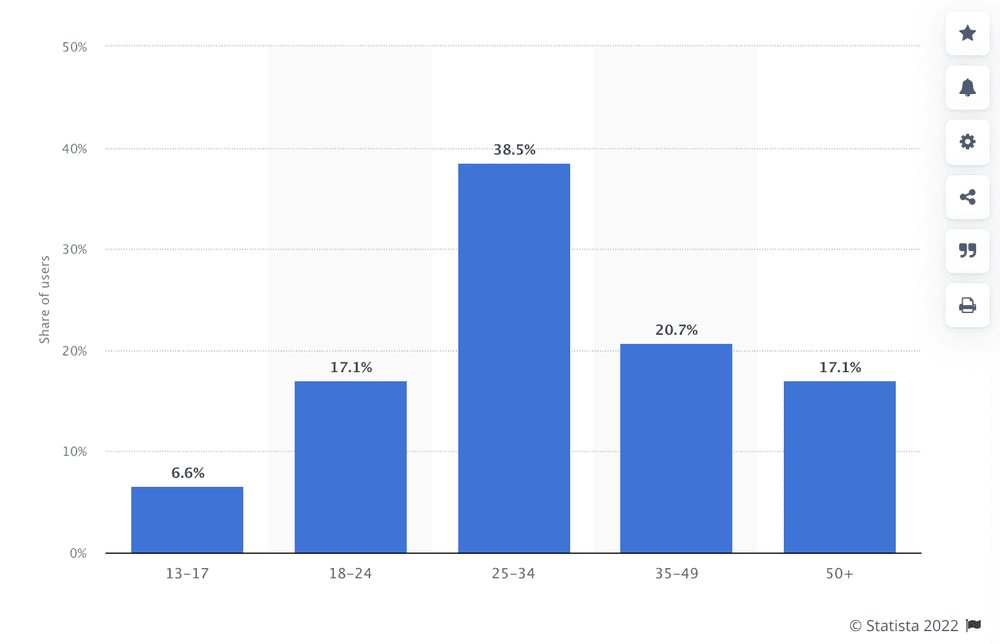
Strategies:
- Engagement: Interact with your audience by responding to mentions, retweeting relevant content, and participating in trending conversations.
- Content creation: Share industry news, articles and insights to position your brand as an authority in your niche.
- Visuals and media: Incorporate images, GIFs and short videos for more engagements.
- Twitter ads: Use Twitter Ads to open your business up to a broader audience.
- Twitter chats: Host chats in your industry to connect with like-minded individuals.

LinkedIn may be a setting for more professional content, but that doesn’t mean humorous, light-hearted material can’t slip into the mix here and there.
One of the best things you can do to help your brand stick out on LinkedIn is to post industry-related memes that interrupt the river of posts centered around other businesses’ news or opinions. We love anything the Marketing Millennials puts out on LinkedIn, as it’s always humorously rooted in industry truths:
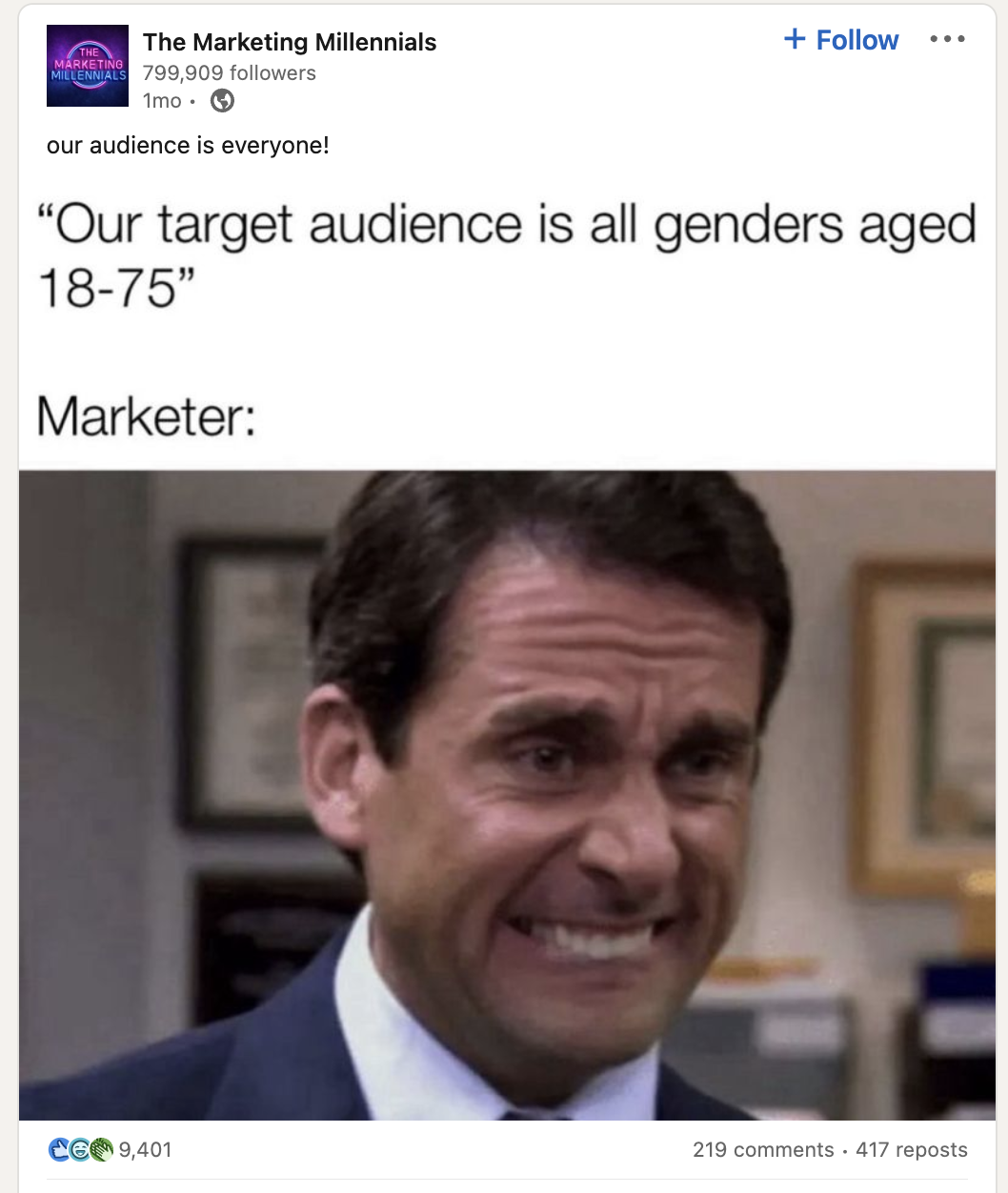
Audience
LinkedIn is a professional networking platform, making it ideal for B2B marketing and career-related content. You’ll also want to target men in the 25-34 age group:

Since most of LinkedIn’s audience is Asian, white, and Latin American, and you’ll want to target audiences in the USA, India, Brazil, China and Indonesia.
Strategies:
- Optimize your profile: Create a professional profile for yourself, complete with a general summary of your work experience and a headshot.
- Publish articles: Share thought leadership content through LinkedIn Articles to establish authority in your field.
- Company page: Maintain an active company page where you post updates, company news, industry insights, and job postings.
- Networking: Connect with professionals and participate in discussions such as industry tips, personal experiences, webinars, and news.
- LinkedIn ads: Run advertising campaigns to reach a professional audience based on job titles, industries, and more.
YouTube
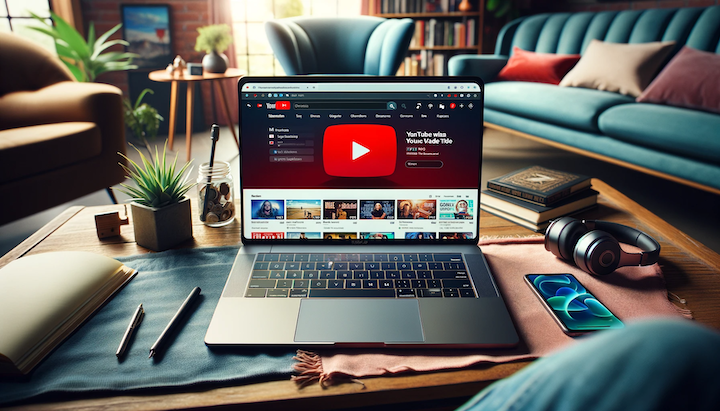
YouTube is still a really solid choice when it comes to marketing video content for your brand. Videos create a personal connection that other formats may lack. They’re stimulating for both the eyes and ears, which can embed your brand’s image into your viewers’ minds faster than static media will.
The videos that tend to perform best on YouTube include:
- How-to guides
- Reviews
- Entertainment
- Educational videos
- Vlogs
- Gaming
- Unboxing videos
- Podcasts
Audience
YouTube is a video-centric platform with a diverse user base. It’s ideal for video content creators and businesses looking to share tutorials, reviews and demonstrations. You’ll want to target male audiences in the 25-34 age group:
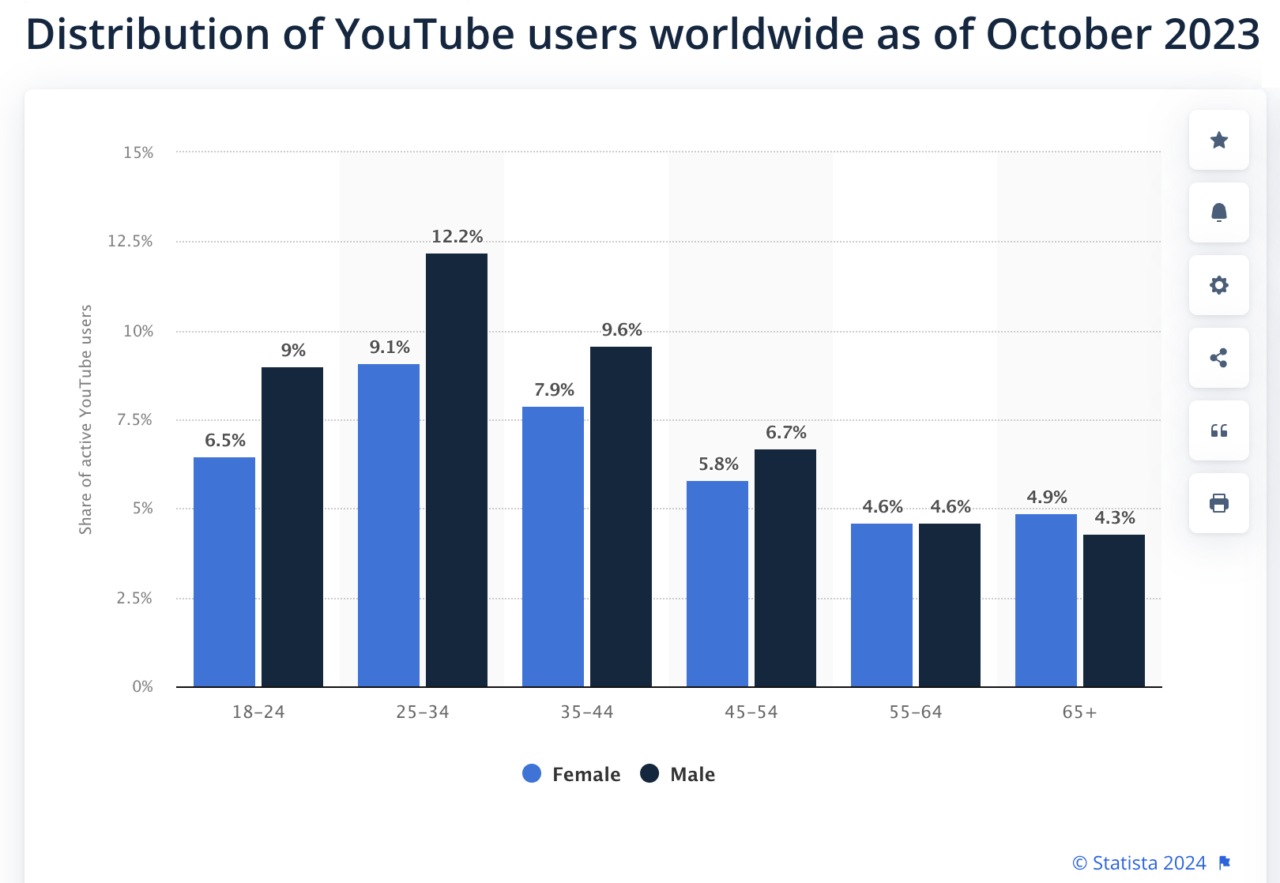
Strategies:
- Video content: Create high-quality, engaging videos that address your audience’s interests and pain points.
- SEO: Use relevant keywords in video titles and descriptions to improve discoverability. Choose keywords by gauging search traffic and competition.
- Topical Consistency: Create a regular posting schedule to keep your audience engaged. Make sure you’re maintaining the same type of topics with your videos. One of the biggest reasons people unsubscribe from YouTube channels is because the channel creator veered too far off the path from the type of content their viewers expected from them.
- Community engagement: Respond to comments and consider hosting live streams and Q&A sessions.
- Monetization: Explore monetization options like YouTube Ads, affiliate marketing, or merchandise sales.
TikTok
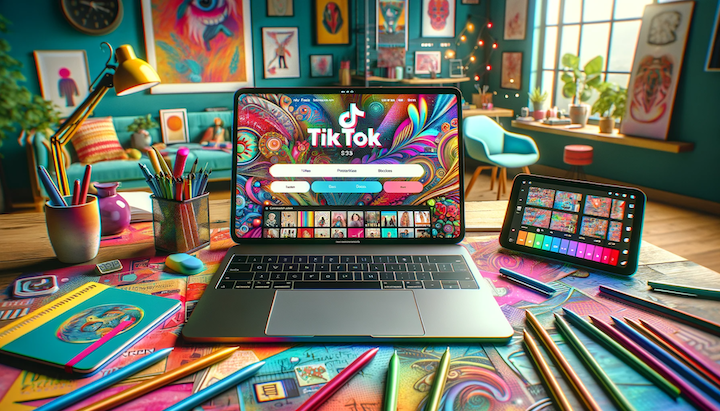
TikTok took the virality of videos on Instagram and doubled down on it, building it into one of the biggest short-form video-sharing apps. It’s great for posting bite-sized snippets of content about your brand that can hook people’s attention quickly.
Audience
TikTok is popular among Gen Z and younger Millennials.
Strategies:
- Short-form content: Create engaging and short videos that entertain or educate your audience. Use popular sounds to boost your content’s visibility.
- Trending challenges: Participate in TikTok challenges; these can be educational, such as “5 Things I Will Never Do As a [blank],” or fun, like dancing challenges.
- Consistent posting: Regularly post videos to keep your audience engaged, increase your interactions, and satisfy the algorithm.
- Engage with the community: Respond to comments and collaborate with other TikTok creators.
- Collaborations: Partner with TikTok influencers to increase your reach.
Monetization on Social Media Sites
While building an audience is essential, monetizing your presence is the ultimate goal for many content creators and businesses. Currently, platforms like YouTube offer robust monetization options, including ad revenue, sponsorships and merchandise sales.
But will other platforms follow suit? The prospect of monetization on platforms like X, Facebook, LinkedIn, and Instagram is not far-fetched. TikTok has already proven that creators can make substantial incomes through the platform.
Keep an eye on other platforms that may introduce similar incentivization models. Remember: the key is to create valuable and engaging content that attracts sponsors and partnerships.
Start Assessing the Right Social Media Sites in Your Strategy
Posting on the best social media sites can help your brand stay relevant and increase your visibility. But before creating a social media strategy, make sure you’re using the right platform. Focusing on the best social media channel for your brand can help you stand out from the competition and thrive in your space.
If there’s one thing you should take away from this post, it’s this: Don’t try to do it all at once. You’ll not only run yourself ragged, but you’ll inevitably have to compromise the quality of your output in order to appease as many different social media sites as you can.
Instead, try picking one or two platforms that you can devote your attention to and concentrate on building your following strong on those before branching out into other platforms.
If you’re ready to level up your brand’s online visibility and audience engagement, Single Grain’s social media marketing experts can help!👇
For more insights and lessons about marketing, check out our Marketing School podcast on YouTube.






